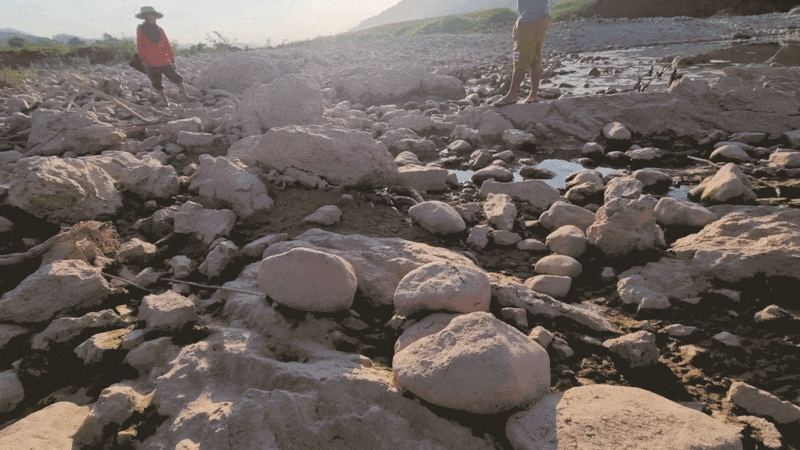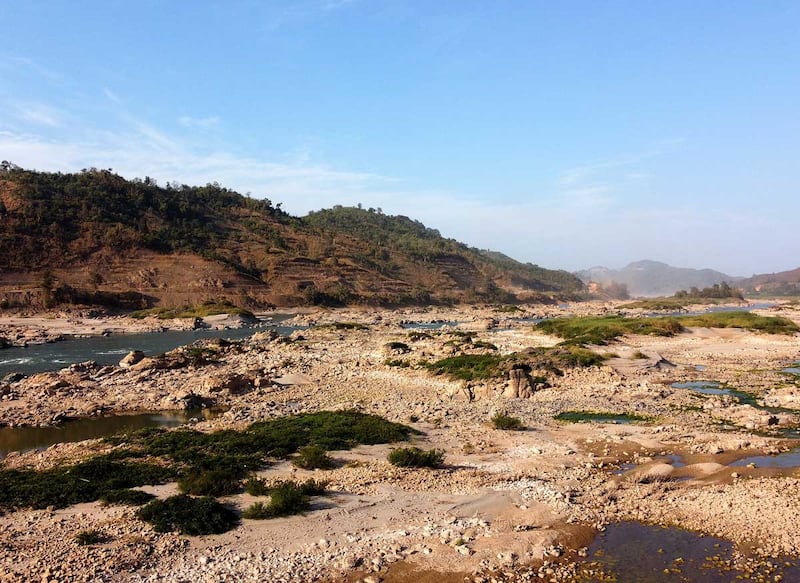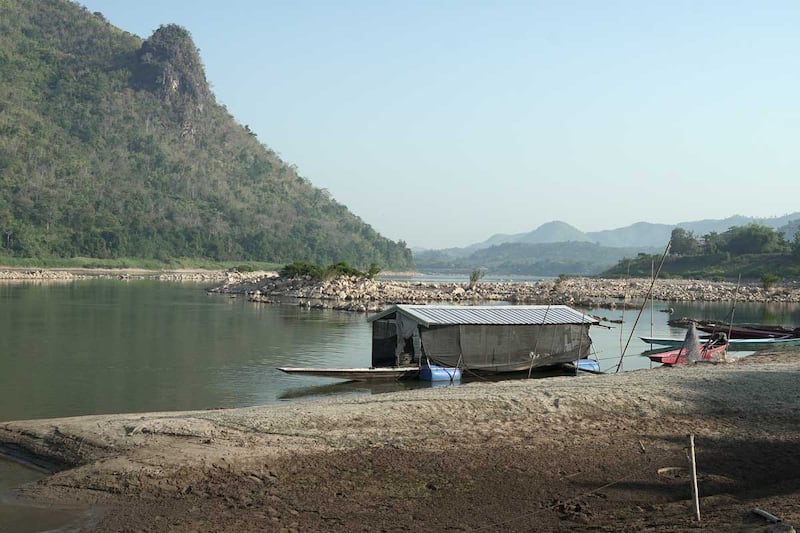The left image shows a full Mekong River in January 2019, while on the right is the Mekong in January 2022. (Planet Labs with RFA analysis)
Laotians and Thais who depend on the Mekong River for life’s necessities — food, water, income — fear the mighty waterway may be drying up.
They say climate change may be a factor in recent droughts in the region, but believe the direct cause of their troubles are the many dams China and Laos have built upstream that siphon off water for agricultural and other uses before it reaches them. Experts say the dams make the impact of periodic droughts in the Mekong basin worse and rob the river of the "pulse effect" that spreads water and nutrients that support fisheries and farming.
[ Planned Lao dam raises concerns in Thailand over impacts on shared borderOpens in new window ]
On the Lower Mekong, fewer fish are being caught and some days water levels are so low people can walk from one shore to the other. With more dams planned in Laos to generate electricity for export, farmers and fishermen fear the worst may be yet to come.
“The Mekong River is dry because of the dams. The more dams we have, the drier the river will become. Nobody is trying to compensate us and mitigate the problem,” said a Thai villager who lives along the Mekong in Loei province.

The Mekong is one of the world’s most biodiverse river basins with more than 1,100 species of fish. As the world’s largest inland fishery, the river is a vital food source for the 70 million people in Laos, Thailand, Cambodia and Vietnam who live in its basin.
But the river’s flow over the last three years has been among the lowest ever recorded, with 2020 the lowest on record, according to analysis of Mekong River Commission data by the Washington-based Stimson Center’s Mekong Dam Monitor project.
The commission is an intergovernmental organization that works with the governments of the four Mekong basin countries to jointly manage the shared water resources and the sustainable development of the Mekong.
“The Mekong River is so dry and so low that local residents can walk across it at some locations like the one between Sangthong district in the Lao capital Vientiane and Pak Chom district in Thailand’s Loei province,” a member of the Thai Mekong People’s Network from Eight Provinces, who declined to be named so as to speak freely, told RFA.

The group represents people who live along the Mekong River in eight Thai provinces, including areas on the border with Laos, and face transboundary environmental impacts from the Xayaburi Dam hydropower project, Laos’ first dam on the Lower Mekong River.
“The Mekong River is not the same — sometimes it is low, and sometimes it is high,” a Lao fisherman, who lives on the bank of Mekong River in Xayaburi province, said. “I can catch more fish in the Xayaburi Dam reservoir than I can in the area below the dam.”
The Xayaburi Dam and the Don Sahong Dam, were the first two of Laos' Mekong mainstream dams, and were completed in 2020. Three others are in the planning or early construction stages as the government looks to generate revenue by selling the electricity from its hydropower projects to its neighbors, especially Thailand.
Laos has 78 dams in operation and has signed memoranda of understanding for 246 other hydroelectric projects, despite uncertainty about Thailand’s willingness to purchase the electricity they generate. China operates 11 mega-dams on the river, with at least two more planned.
Planned Mekong River dams such as Luang Prabang Dam and Sanakham Dam will make the drought worse, added the fisherman, who declined to give his name.
“There will be no more fish at all. I don’t want any more dams on the river,” he said.
The lack of fish is also being felt in markets in Laos capital Vientiane.
“This year, we don’t have enough fish to sell; fish are scarce compared to last year,” a fish trader there told RFA Lao Service on Jan. 14.
Another fish trader said he hadn’t procured any fish for two weeks.
A Lao official who works closely with the Mekong River Commission told RFA that the water levels of the Mekong depend on the amount of water released by China.
“When there is little water coming down from the north, the lower region will have less water,” he said. “Sometimes, there is too much water in the north, so a lot of water is released. That’s why sometimes, the lower Mekong River region is dry and sometimes flooded.”
Recent reports by the MRC and by the Mekong Dam Monitor say the main driver of drought in the Mekong basin is lack of rainfall during the wet season, said Brian Eyler, head of the Stimson Center’s Southeast Asia Program and the Energy, Water, and Sustainability Program.
“The driving factor is a lack of rain during the wet season–no other factors can be so large to account for the gap,” he wrote in e-mailed comments.
“However, we have also determined that by and large, throughout these last three years of low flow, most dams in the Mekong basin were operated the same way as they operated in previous years of high or normal flow,” said Eyler.
The upstream practice of holding back water in relatively low-flow years takes a relatively larger amount of water out of the system, meaning that “dam restrictions during a time of drought hurt the Mekong even more,” he wrote.
The fears expressed by fishermen and farmers reflect the fact that "the impacts of these restrictions are the most noticeable nearest to the dams themselves," added Eyler.
An Pich Hatda, head of the MRC Secretariat, said in a press release on Jan. 13 that the drought has been affecting agricultural production and the fishery industry as well as putting more pressure on livelihoods of those who live along and depend on the Mekong River.
“It’s also been threatening the ecosystem of the river,” he said. “Therefore, aggressive cooperation is important, not only cooperation from China but from all MRC members to tackle this problem.”

A representative from the Network of Community Organization Council of Seven Northeastern Provinces, another Thai group that represents people who live along the Mekong, emphasized the need for sustainable development in the Lower Mekong Region in which residents have genuine input, in comments to a Mekong-U.S. Partnership seminar on Jan. 10.
The U.S. and five lower Mekong nations launched the partnership in September 2020 as a new multilateral cooperation framework amid growing concerns about China’s expanding influence in mainland Southeast Asia.
“In the last five years, our Mekong River has had a lot of problems with the water becoming clear [because of the] lack of sediment and food for aquatic species,” the representative said.
“The water level is down by more than half, [and] the river is flooded during dry season and dry in wet season.”
“It’s not normal,” he said. “The water turns blue, affecting the ecosystem, natural resources, the environment, and the fish population.”
Reported by RFA’s Lao Service. Translated by Max Avary. Written in English by Roseanne Gerin.
